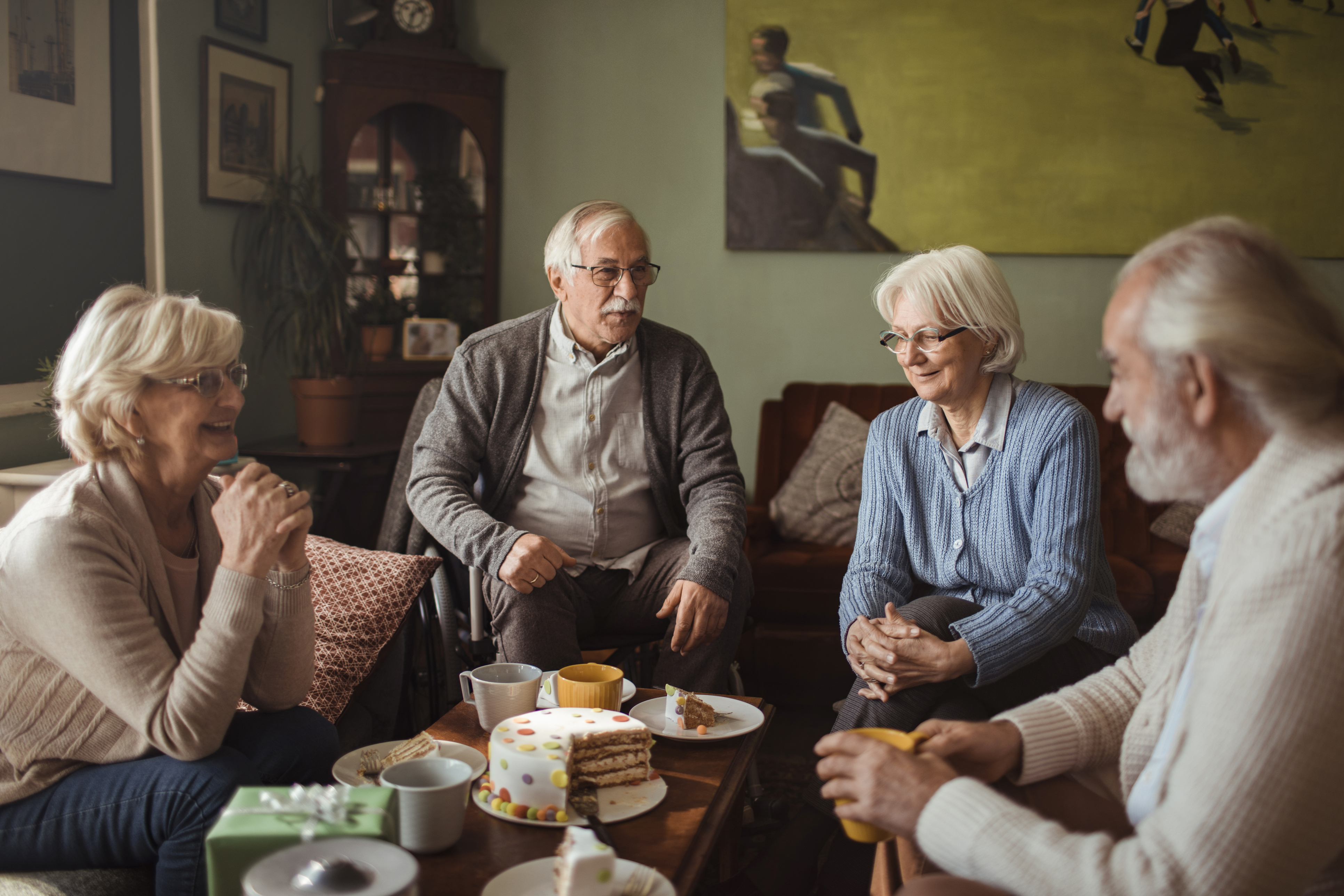How To Support Loved Ones With Dementia and Alzheimer's Disease
by Kristen Hampshire | May. 21, 2021 | 12:00 PM

It all came to a head December 23, 2019. For several years prior, Jim Smith had supported his wife after her diagnosis of vascular dementia and early onset Alzheimer’s, which caused fainting spells and periodic paramedic trips to the hospital. But a couple days before Christmas, the situation grew progressively worse.
“Sally had a terrible episode of collapsing in the bedroom and breaking a lamp, and me being unable to help her up to her feet,” says Smith, who’s 90 and celebrates his birthday two weeks before his wife of 62 years.
Smith had been attending counseling with an Alzheimer’s group to cope with the diagnosis, and someone suggested perhaps they relocate Sally to a facility that could help with her needs. They’d been living in their Chagrin Falls home since 1977, visiting a place in Maine every summer for decades. But the seriousness of the fall and Smith’s need for more outside support added a new perspective.
The couple had already applied to move to Judson Park, so Smith immediately reconnected with administration there, who arranged for Sally’s move to a nursing care space so she could recuperate from the fall and the couple could begin planning what was next. From then on, Smith drove to Judson Park almost every day to spend time with Sally in Judson’s Reinberger Memory Care space until he moved into an apartment on the third floor in November 2020.
“The hardest thing was coming to grips with what I knew was coming,” Smith says of selling two homes and transitioning well-established lives to a new environment.
The best thing has been the sense of community, caring and resources that the Smiths could not have accessed at home. Smith shares how Judson’s staff put together a photo book that includes cards Sally has received so they can look through memories together.
“We communicate with our eyes, hands, touch — and Sally understands my talking even though there is not too much of a response,” Smith says.
For those caring for loved ones with Alzheimer’s and other dementia diagnoses, layers of support can help ease feelings of loss as they transition to a place where care can be provided. According to the Alzheimer’s Association, about 6.2 million adults 65 and older are living with Alzheimer’s or dementia, and 72% are 75 and older. Two-thirds of Americans with the disease are women.
“They say it takes a village to raise a child, and it takes a village of people to surround a person who is diagnosed with Alzheimer’s,” says Jessica Kulczycki, Judson Park’s community life and CARE director. “Building a support team right off the bat is really important, and so is preparing for the future, and part of that is not being ashamed or afraid to talk about it.”
Warning Signs
When is forgetfulness a result of stress and anxiety — and when is memory loss something to be concerned about?
“While it is typical to have forgetful moments as we age, what is not as typical are things such as telling a story then repeating it five minutes later,” says Amy Sanfilippo-Steadman, vice president of acquisitions and development at Sprenger Health Care Systems.
Other common signs include not remembering how to complete everyday tasks that contain multiple steps or forgetting the names of immediate family or the day of the week. Kulczycki says these experiences make you pause.
“And sometimes it’s personality changes,” she adds. “You could have someone who is really calm all of their lives, and all of a sudden, they are losing their temper really fast for no apparent reason. Or, someone who has never sworn — then the language comes pouring out.”
According to the Alzheimer’s Association, a sign of early onset Alzheimer’s is forgetting recently learned information. However, typical age-related forgetfulness is not remembering appointments or names, but remembering them later. Another red flag: having difficulty completing a daily task like driving to a familiar location.
Other common symptoms include confusion with time or place, trouble understanding visual images and spatial relationships, new problems with words in speaking and writing, misplacing things without the ability to retrace steps, decreased or poor judgement and withdrawal from work or social activities. Early detection of these symptoms is key.
“It’s important to have the conversation as soon as possible while symptoms are in early stages,” she says. “This will provide the individual with the ability to voice their wishes about their upcoming future while they are still able.”
Sometimes, loved ones can write off clear warning signs because they are not sure how to broach a tough conversation — or they figure the symptoms are part of getting older.
“People can get scared or think they won’t need help until down the road but being prepared is important because the disease is so individual,” Sanfilippo-Steadman says.
Along those lines, the way to approach loved ones who show possible signs of dementia is also very individual, and the conversation will depend on the relationship.
“Start with open-ended questions,” Kulczycki advises.
In the case of a spouse, suggest that you’ve noticed some difference in behavior either with morning routines or daily tasks. Children approaching parents about the issue might want to hone in on small changes in behavior. Families and loved ones can come together by attending groups where they can meet others who are dealing with the same concerns.
“Loved ones often have feelings of guilt when they are no longer able to care for their loved ones at home and a sense of loss that their husband, wife, mother may no longer recognize them,” Sanfilippo-Steadman says. “Upon speaking to many families over the years, they have success attending support group meetings.”
Moving to Memory Care
Transitioning to a community with care supports in place is challenging no matter the circumstance, and those with Alzheimer’s can feel especially confused, anxious and overwhelmed by the change.
“It’s difficult for the family members affected to have their loved one move out of their home, and it is also a change for the person who may already be suffering memory loss to move to an unfamiliar facility,” Sanfilippo-Steadman says.
Items from home can make a new place feel more comfortable.
“It’s a big leap,” Kulczycki says. “Helping recreate their environment with some of their favorite pieces from home can make them feel connected.”
Talk to the facility in advance so they can be clued in on some of the little things that are important to your loved one like their favorite thing for breakfast. Also helpful are picture books, music, an ability to go outdoors for a walk and activity centers that remind them of familiar situations, whether at work or home.
Lee Ann O’Brien, chief marketing officer at the McGregor Foundation, recalls a gentleman who got up every morning and got dressed up in pants, a white shirt and suspenders. “We found out he had been a COO at a major corporation,” says O’Brien. “So, we set up a desk for him like he was going to the office. We gave him a pad and paper, and we found an old adding machine. He would sit for hours and busy himself in his ‘office.’ ”
And while finding someone their own age they can engage with is easy, O’Brien says they are stimulated by youth and multi-generational programming provides much needed stimulation.
“Have children ask them questions about their experiences and get them talking about some life lessons,” says O’Brien.
A sense of community is critical, including providing conveniences such as an on-site dentist or nurse practitioner so individuals do not have to enter stressful situations such as waiting rooms or deal with transportation.
“Look for how a facility includes schools, children and families,” suggests Kulczycki. “Are they connecting with educational programs or talent programs that keep people engaged? Pet visits are also wonderful.”
Coping in the Moment
Flexibility is the key to approaching the disease, overall.
“The hardest thing is we are always trying to keep loved ones in the present when, in fact, they may have found a more pleasant place in their life to go and that is where they are ‘living’ now,” O’Brien says. “So, the concept of joining their journey is to discover where they are in their life and share memories, make it comfortable.”
For example, when a resident said to O’Brien, “Look at the green sky,” rather than question or correct the phrase, O’Brien responded with, ‘And what a beautiful shade of green it is. Tell me about what you see.’ ”
Coping with Alzheimer’s requires care for the caregivers, too. According to the Alzheimer’s Association, there are 11 million “unpaid caregivers” or family and friends who, in 2020, provided an estimated 15.3 billion hours of care.
For Smith, having a group he could talk with helped him connect with others and plan for his and Sally’s future. The programs for Sally — including music and art — plus the socialization and support she receives, has resulted in a smooth-as-possible transition.
“It’s hard for families, and we’ll all have good and bad times,” Kulczycki says. “So, we have to be present and in the moment, and that’s important to have that staff and culture in a community.”
Trending
-
1
-
2
-
3
-
4
-
5










